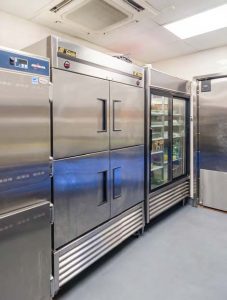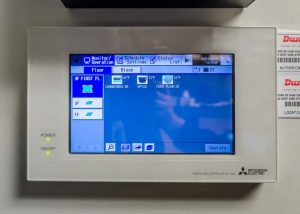
Thanks to years of experience serving the New York City area, Arista Air Conditioning Corporation knew that a Variable Refrigerant Flow (VRF) zoning system from Mitsubishi Electric US, Inc. Cooling & Heating Division would fit the bill for a new restaurant whose originally planned system proved unworkable. The VRF system also provided cost savings over the chilled water system originally specified.
System Meets NYC’s Strict New Noise Standards
Fogo de Chão® (Fogo), headquartered in Dallas, TX, is a Brazilian steakhouse known for its exceptional dining experience. Fogo began in Southern Brazil 35 years ago and has grown to 37 locations across Brazil, the United States, Puerto Rico, and Mexico. Fogo recently opened a New York City location directly across the street from the Museum of Modern Art, on West 53rd Street, between 5th and 6th Avenues.
The original HVAC design for the restaurant—a water plant on the roof—posed issues of code-compliance, cost, and unsightly ductwork. Dale Forester, the construction manager at Fogo, said, “Due to new noise standards, the water plant would have needed to come up to code. New York City has really strict regulations, and the noise levels from the previously planned HVAC design would have far exceeded them.”
Stanley Berger, CEO of Arista, based in the New York City borough of Queens, added, “Bringing in heat would have required bringing in many gas-fired boilers. That would have cost quite a bit.”
Arista Project Manager John Stewart further explained, “The chilled water system was spec’d for 180 tons with two 90-horsepower compressors. This was designed by an engineering firm outside of New York City and would have required an operating engineer at an additional cost.” Berger noted the chilled water system also would have required a new and expensive controls system.
Arista suggested an entirely differentroute: VRF. Berger said, “VRF’ssimultaneous cooling and heatingcapability means you can have heatcoming from one handler, coolingfrom another—any combination youwant. There’s tremendous energy savingsto that.”
Fogo did an energy analysis comparing the chilled water and VRF systems. Forester said, “We saw that using this [VRF] system over chilled water dropped the current load by 300 amps, offering tremendous savings.”
Zoning Guarantees Customer Comfort
Forester liked the idea of VRF but was unsure how the zoning would perform. Arista brought him to multiple installation sites around Manhattan. “In one steakhouse, I saw how the kitchen and dining room were separated into zones. This was in the wintertime, and the heat in the dining area was nice and warm. I was surprised at how well the dedicated zones worked,” Forester said.
The team was in agreement: VRF would save money while ensuring guest comfort. Berger said, “We’ve been working with Mitsubishi [Electric] for about 14 years and have installed several hundred jobs. It’s a fantastic product, and the machines operate under much more severe conditions than traditional systems can. It can be 120° in these spaces and VRF still works. We feel so positive about it that we put VRF in our own office.”
Two-Pipe System Saves Space
R2-Series units were selected for the majority of the project for their simultaneous cooling and heating capabilities. One Y-Series unit was selected for the main dining room. Berger explained, “It’s such a big area and it wasn’t necessary to have each air handler be able to operate on its own.”
The outdoor units went on the fifth floor setback. “We installed structural steel for the 84 tons of Mitsubishi [Electric] condensing units. We then ran piping from the roof down through an outside shaft into the building, connecting to about 30 air handlers,” said Berger. Forester added, “Other [VRF] brands use three-pipe systems. Mitsubishi [Electric] having just two pipes really helped.”
Fogo has since installed Mitsubishi Electric VRF at their Portland, OR, location. Forester said, “In Portland, the challenge was a lack of space on the roof. Mitsubishi [Electric] offered the most efficient use of space. Inside, Mitsubishi [Electric] solved the challenges of low ceilings and tight spaces quite easily with their two-pipe system. From these successes, we consider Mitsubishi [Electric] a preferred partner for this equipment.”
User-Friendly Monitoring Minimizes Maintenance
The system has been in place for over a year now, “and we’ve really had no problems at all. No mechanical issues, no repairs,” said Berger. Forester commented, “The HVAC works well. At the street entrance, when it’s 20° outside, if you walk in 10 feet, it’s warm. The zoning of the air also works really well with the three-level restaurant. There is a tendency for heat to rise, but the system can maintain all floors of the building at 72°. It’s designed very well.”
Part of that smart design is user-friendly monitoring. Fogo monitors its equipment via a control panel in the manager’s office. “It’s very simple to use for the amount of technology it has. There’s also diagnostic programming, online diagnostic programming, filter changes, etc.,that are all very easy to use,” said Forester.
Code-compliance has not been a problem, either. “With the variable frequency drives of the Mitsubishi [Electric] units, there is literally no noise,” said Forester.
For more information, visit www.mitsubishipro.com.




